In the winter season of cold, snow and holiday music, the North American bird breeding and nesting season seems months away. It’s not until the trees begin to bud and flowers bloom that the birdsong fills the air.
And that’s true. But not for great horned owls.
Winter is the time to enjoy the great horned owl breeding season–a time when these charismatic birds are much easier to see and hear.
It’s the hooting season.
Don a winter cap and head out to your local park or walking trail to enjoy one of the season’s coolest spectacles. Here’s what you need for your next owl outing.
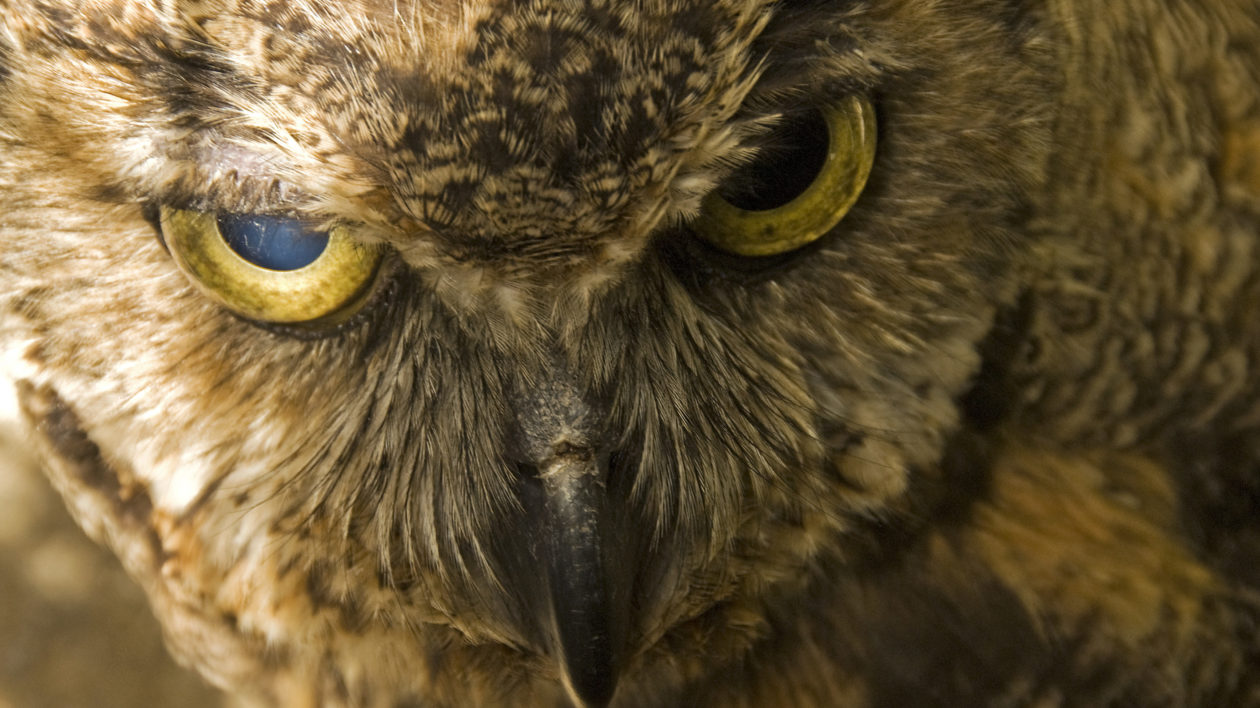
Into Owl Territory
The great horned owl, of course, is one of the most recognizable birds in the Americas, with its pointy feather tufts (the “horns”) and large fluffy appearance.
This is the prototypical “wise old owl,” and the owl of cartoons and children’s books.
It’s also incredibly adaptable, found from Canada to Patagonia, and most places in between. It is at home in desert and wetland, forest and prairie. And it also has no trouble thriving around people: you can find them in parks, farms, small woodlots, suburbs and cities.
Despite this, they’re not always easy to spot due to their nocturnal habits. But at this time of year, in the right location, a chorus of hoots provides the soundtrack to dawn and dusk.
That’s because, around October, male great horned owls begin setting up territories. Most great horned owls mate for life, but in the fall the pair begin a courtship display, loudly calling to each other.
Become a Member
Make a lasting impact for nature when you join The Nature Conservancy
The great horned owl’s hoot is pretty much unmistakable, although ornithology web sites often describe it in different ways. A common hooting pattern is a longer hoooooot, followed by two or three shorter hoots.
And these owls have a range of other vocalizations, too, some of which sound like barks or a screeching cat. (Cornell’s All About Birds site features some great audio of these different calls).
The owls continue setting up their territory this month, and begin setting up a nest.
They’ll use an abandoned nest previously used by a red-tailed hawk, squirrel or other critter. Come January, they’ll begin setting in the nest–far earlier than most other birds.
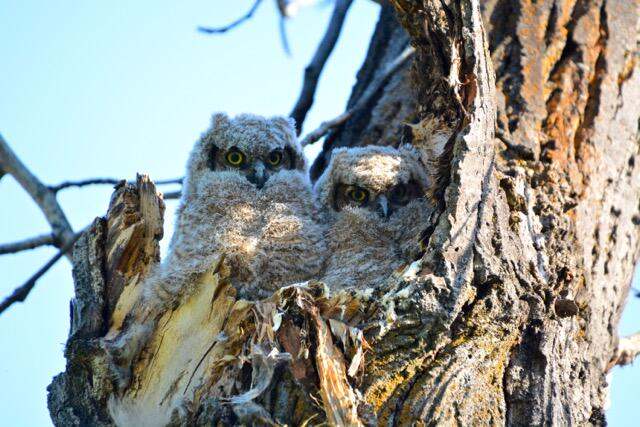
Why Do Owls Nest So Early?
Nesting early naturally entails some risk. Eggs must be kept warm and incubated, which can be a challenge when the temperature is in the single digits and snow is falling.
Female owls stay on the nest for prolonged periods (and when they leave to hunt, the male will take over).
If the eggs become too cold, they won’t hatch. This is why most birds wait until temperatures are warm and mild.
So: why nest early?
Owls are large birds. It takes them longer to grow and mature than, say, a songbird.
Young great horned owls must also master complex hunting maneuvers. They are equipped with superb senses – researchers have found that a great horned owl can hear a mouse rustling at 900 feet – but hunting still involves learning, trial and error.
Early hatching means they’re ready to practice their flying and hunting skills when the weather is mild and prey is abundant.
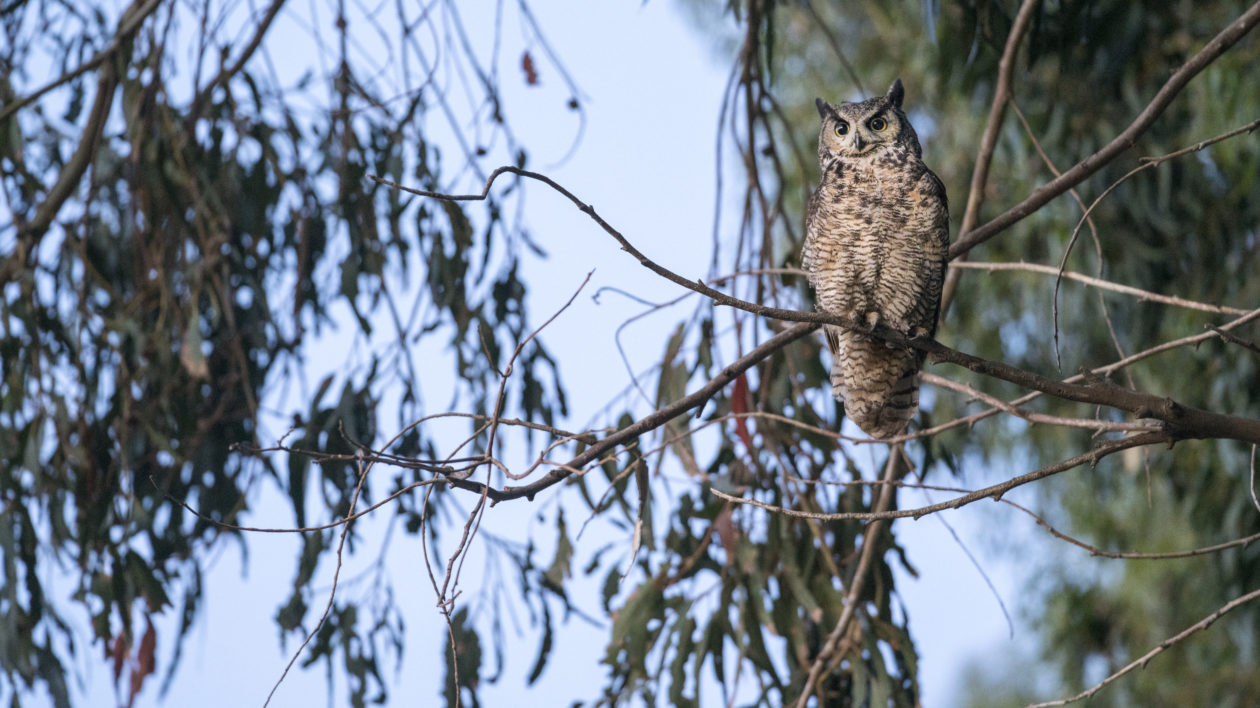
Enjoying the Owl Show
There’s likely a great horned owl territory near you. Now you just need to find it.
While owls can live in a variety of habitats, you won’t find them just anywhere. Focus on the edges. Owls prefer to have a good vantage point – a place where they can see out over the terrain.
Trees that overlook an open area are ideal. In particular, try to find a big-limbed tree that has shed its leaves (or a dead one). You can often find owls roosting there.
You can do a bit of scouting, too. Owls regurgitate the indigestible hair and bones of their prey: called owl pellets. You can often find a number of these pellets below preferred trees. (You can often reassemble the bones of mice by dissecting an owl pellet, another fun wintertime activity).
Of course, the easiest way to spot owls is not by looking, but listening. Those haunting hoots carry a long way. Sometimes you almost feel those hoots before you see them.
Once you hear the hooting, look carefully in likely trees, and you may be able to see the distinctive profile of the owl. Look through a binocular, and don’t be surprised if the owl is staring back at you.
It pays to quietly observe the owls for a while. I’ve been able to watch some interesting behavior, including owls mating.
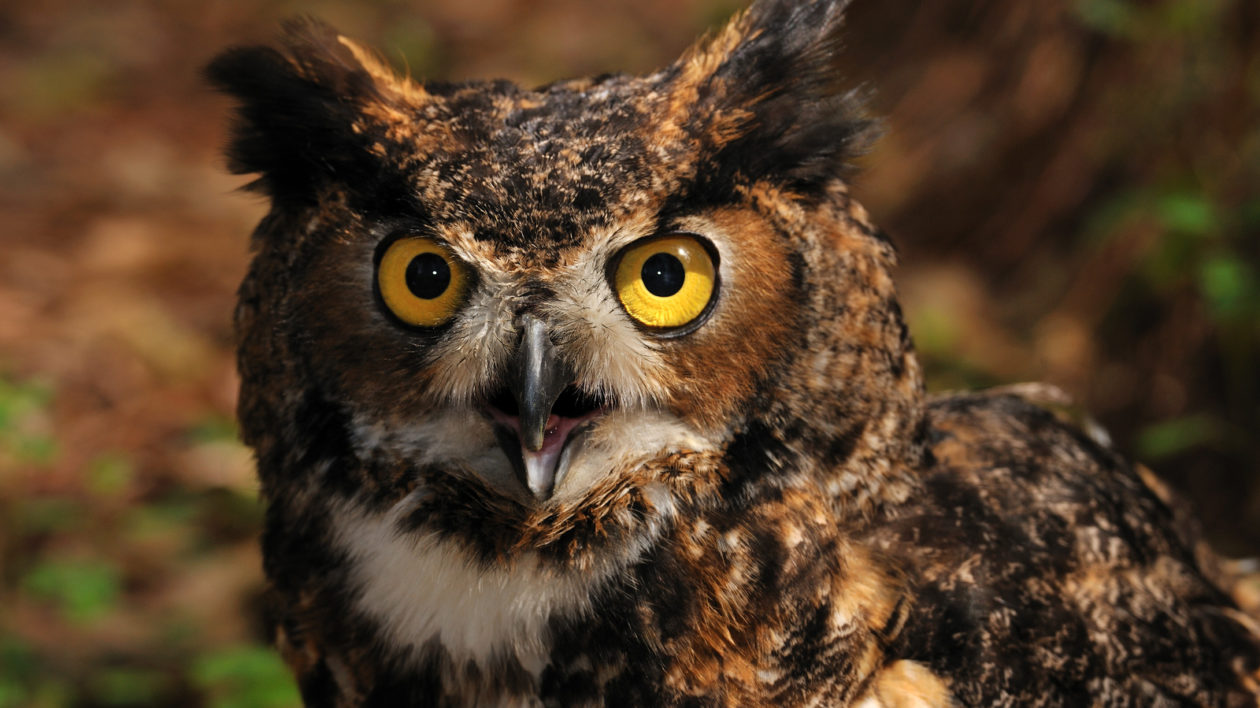
Photo © Mark Conlin, courtesy of Tallahassee Natural History Museum
My Owl Connection
Family lore holds that, long before I could utter words, I would lie in my crib and hoot like an owl. Perhaps my naturalist path was set, even then.
That story has been in my thoughts this year, as I prepare for the birth of my own son. The great horned owls, it seems, are everywhere. I see them perched on trees around our home and along the greenbelt jogging path; hear their calls in the canyons and river bottoms.
I’m always alert to the local wildlife, but this year, I can’t help but pay extra attention to all that owl activity.
I wake up in the middle of the night, thinking of my son and the world he’ll inhabit. And then, there it is: that deep hoot, hoot, hooting.
It seems to fill the room.
I snuggle under the covers and smile, filled with the hope that my son will find such comfort and joy in the wild things and their always-interesting ways.
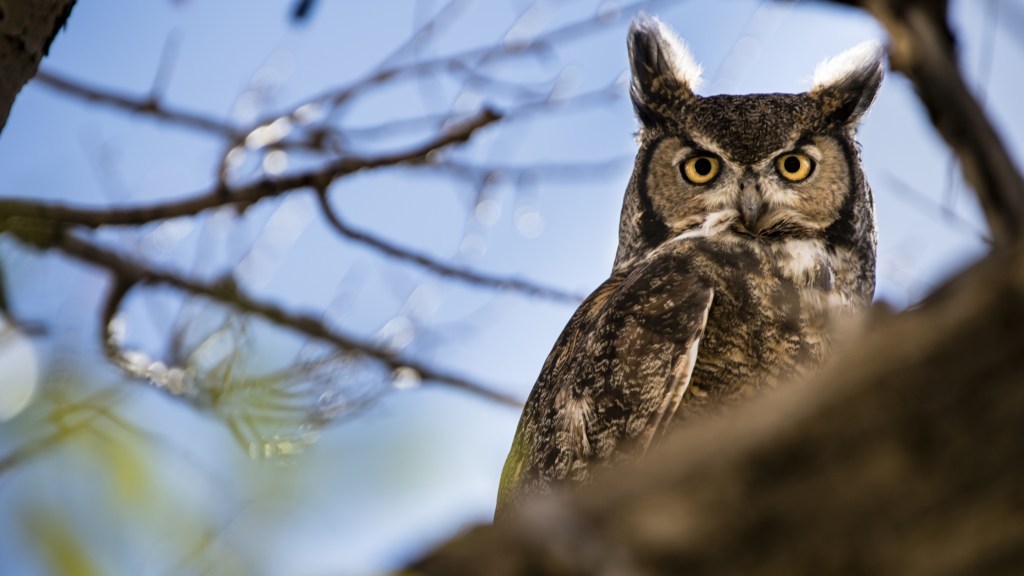



I started hearing the hooting of owls in my backyard just today! I was surprised to hear it over and over especailly during the day. I finally saw one perched on a tree with a couple of crows bothering it. This all was so new and exciting to see. I googled owl howling and came upon your article. You have explained plainly why this is happening. Your article was so interesting and to the point of my experience today. So as I have walked out into the cold evening air and listened, I now know what is happening. Thanks for sharing this info.
Hi, we live in NW Arkansas in a Bentonville neighborhood and have a pair in our back yard. Our home is adjacent to a large field with a hedge row about 200 yards away. Clearly it is a good habitat with prey species nearby and we see coyotes, crows, hawks and an occasional Bald Eagle hunting there. I hunt turkeys, coyotes & deer in AR, KS, MO & NE and enjoy observing nature including owls but my wife does not have much contact with nature except for song birds she feeds. She is fascinated by the owls’ hooting but intolerant of hawks, roaming house cats, etc. preying on “her” birds including Bluebirds, Baltimore Orioles, et al. Maybe I should suggest that owls prey primarily on house cats?!
I enjoyed your article! Thanks!
There is hooting going on up in New Smyrna Beach area. The two owls are in separate trees, but hoot back and forth around 9:30 at night . We have Hugh oak trees that survived Hurricane Matthew this Fall. Haven’t heard them much, but, I see poop under the tree. So, I guess she is nesting. I hope she is there. So exciting.
So why is it, if your inside and get binoculars, they would be staring back at you? Owls scare me i cant sleep that hoo hooo hooo hooooo hoooo, I’m sorry isnt majestic its FREAKY past 4 years tree right outside my window
Matt, thank you for the “owl info”. I live in Kansas and have been listening at night to several owls.
I am trying to distinguish which is male and which is female. Any insight on that would be great.
I plan to listen for the rest of the winter and hopefully get to see some young ones next spring.
Thanks Again, Debbi M.
My owl has been single for the past three years. Does he think that I am his mate with me mimicking his hoot? I am starting to wonder this now as he has been getting slowly closer to my balcony. Is it possible he thinks I am another owl? Also he seems to stick around all year. We live on a golf course in Florida and sometimes we take walks and he watches us but this is in daylight so he is in clear vision just staring down on us. As we walk around we look up and he’s moved to the roof watching us. Then he visits at night too and hoots outside our bedroom window until I hoot back. After that he will leave.. I have grown very attached to him and will miss him when we move to NC in March. Are there any Great Horned Owls in NC do you know?
I am curious as I have had this great horned owl outside my balcony window perched on a branch for the past three years. He comes and goes but every pre sunset and again around 11pm he perches on this same tree outside my window and hoots until I hoot back usually having to get up out of bed. Once he hears my hoot he seems to settle and flys off. If I don’t he keeps on going. It’s a strange ritual. Also sometimes we will come home in the evening and he’ll be on a different tree by our car at the front but by the time we get up our four flights he’s beat us to it around the back of our condo back on his tree hooting. Once I went to take garbage out I’m on fourth floor and he startled me as he was literally on my roof staring down at me. We hooted and he left. Can you shed light to any of this. My husband thinks he fancies me. I think it’s my wise old owl Dad watching over me?.
I live in Apple Valley, California, which is about halfway between Las Vegas and Los Angeles – we call it the high desert, as opposed to Palm Springs, which is low desert. About a month ago I started hearing owls hooting and finally discovered two Great Horned Owls sitting in a large palm tree in the yard. They appear to have their eyes closed until they hear the bell on my little poodle’s collar, then I can see their eyes following my dog. I would like to know if I should be concerned about them swooping down and grabbing my dog. I think at fourteen pounds, she is probably too big for them to carry off, but I’m sure they could quite a bit of damage if they tried to grab her. I really like hearing the owls every evening and want them to stay because they’ve been catching the rabbits that destroyed my lawn this year.
I am on the northern skirt of Houston Tx. Where I am is called Cypress Tx. I live in an old subdivision
honored by trees that have been long before the homes that surround them. For the past 2 month at night began to hear the HOOT, HOOT, Hooooooing sound. I have lived hear for about ten years. First time for this wonderful but hard to pin-point sound. Often sounded like it was in my front yard but as soon as I would sneak closer it was the next yard, then the next, but actually down low in the yard. Not trees. At first I thought it was a sick or hurt animal. Soooo loud so close to the ground. Our area is known for hawks. Never this sound. With a Little more internet research I have found I have a great horned owl making a home on my street. Today is Oct. 30 and I am out once again chancing the sound. I find tonight it is mirrored by another. It’s a pair! I’ve read this is common, but I know most every squirrel, possum , raccoon, frog and of course hawk , and even the worst, blue Jay (The worst parents in the world by the way my opinion) in my yard so this is very exciting for me. Especially now that I know its not a sick crane or odd reptile. I know that sounds strange but the nights I followed the sound it was down low, just assumed it had to have 4 legs. I know now, it was getting food. Just unexpected. Youst to swooping hawks in the day, plus thought all owls these days were rare and fig newtons of the imagination unless you lived near a barn or standing next to a painting of one. Glad to know I’m wrong. Would like mention in our subdivision newsletter so every one can help the pair to have a happy home here and babies, but don’t know if calling attention would help do exactly that or the opposite . Regardless, as an individual that is called squirrel girl by those that luv me, named re-acquiring critters in my yard- raccoon (sketchy Geoff) rabbit-(jerry lewis) and possums too many to count, I’ve accidently pulled out of our outdoor kitty house to bring in kittys at night, would like to know anything at all that I/neighbors can do to help or improve there chances to survive. These days its hard for us humans to make it as a pair, seems like even tougher to be an Owl pair. Thank you in advance for any help or advice you can share.
Cyndi Geary
Beautifully written and full of insight. Thank you! And best wishes to you and your family! Happy Hooting!
I live in southern Saskatchewan Canada. We have a cabin on a small lake, we have great horned owls that have taken up residency here.
I have seen them a few times and love hearing their hoots.
Last night they were hooting back and forth it was magical!
I had some great Horned owls hooting in my yard at night…I mimicked their hoot f and they came even closer! It was very kool…they actually answered…
Wonderful article. I really enjoyed learning more than what I came looking for. 🙂 I live in N.Fla. just a walk from the Suwanee River. We have seen owls over the last 40 years on our farm but lately they are right in the trees around the house and just began 3-4 weeks ago, during the start of our hottest months. Well, all months are basically hot here in Florida. But I was just wondering why the change in location and season. As your son is probably walking and hooting now, I wish you all the best days with him. Spend every moment you can with him and treasure them all. Thanks again from Florida.
Late to the “party”, but this is the info I was seeking.
We moved into our new home in northern Idaho in February….and heard the beautiful, haunting hoots of a pair of GHO’s nearby. Then they stopped, but I heard nocturnal noises (chirps & chatter) which I later learned came from GHO’s as well. Turns out we came on the scene later in the courtship and are now entertained by the juveniles. Fascinating creatures. I enjoy taking a few minutes at the end of the day & eavesdrop on the feathered family.
I have a question-
Last night-May22,2016-there was an owl hooting match in the woods adjoining our house- It went on for hours and sounded like more than a parliament arguing about the budget if you know what I mean. My dogs were very disturbed as well. I thought that horned owls mated in Jan. What was the commotion going on last night?
Any ideas?
Hi Gloria,
Thanks for your comment. While great horned owls do mate in the winter, they are active year round. I have heard wild hooting throughout the spring. Owls pair up for life, and call to each other to reinforce the pair bond. So you can hear them at any time of year.